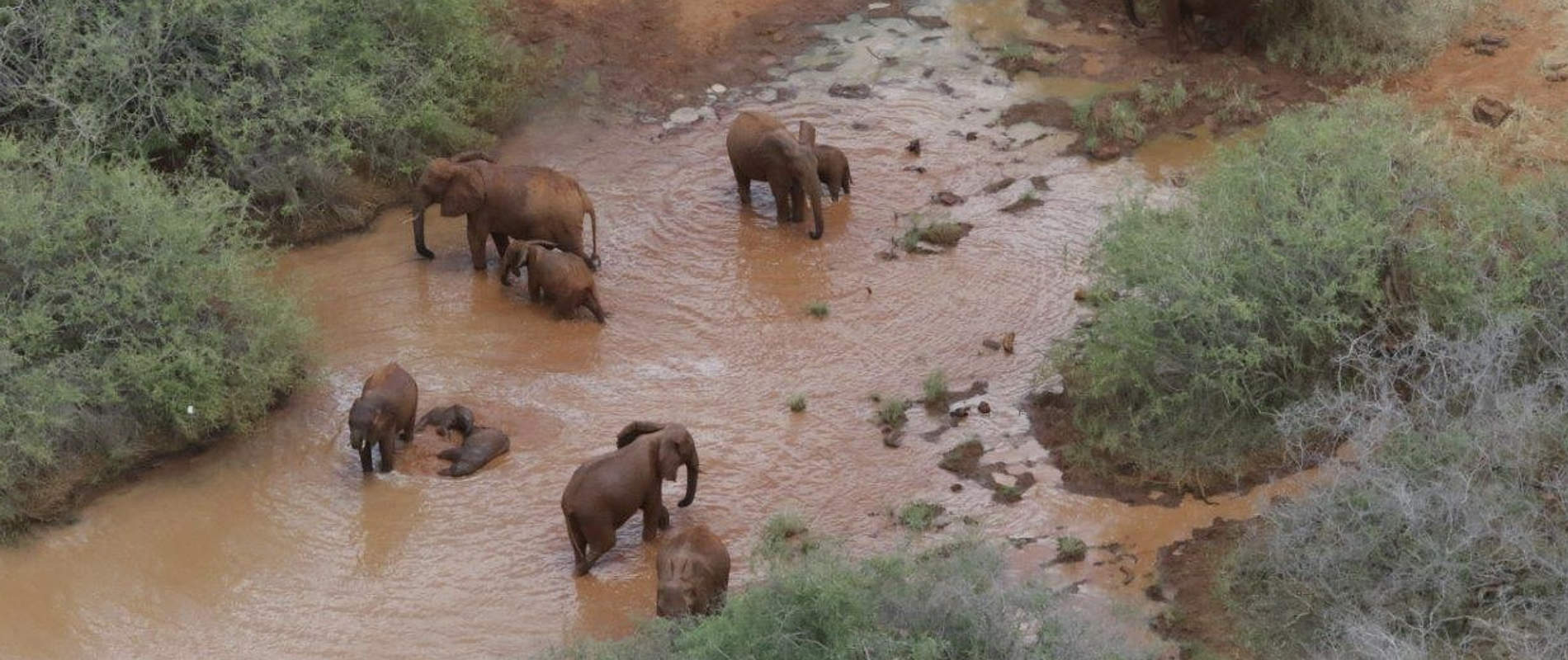Following three months of increasing illegal activities, things slowed down a bit in April. It was still a very busy month for our Aerial Unit, as our pilots continued their patrols and supported all manner of field operations.
Unfortunately, illegal livestock incursions remained a persistent challenge, particularly in Tsavo West National Park. In the southern sector, over 10,000 head of cattle were recorded in a single patrol. The recent rains and green vegetation provided too much temptation.
However, a concerted effort was mounted by KWS to address the issue. SWT assisted with aerial surveillance, both to ascertain the distribution of livestock and assist KWS ground operations more directly. These efforts are ongoing.

In Tsavo East, fewer livestock incursions were observed; however, livestock did occur in larger numbers and much deeper into the Park than has been the case recently. Towards the end of the month, livestock had mostly been removed completely.
Whereas illegal activity decreased, there were still a number of orphaned or abandoned elephants reported throughout the month across the Tsavo Conservation Area. A total of four baby elephants were rescued. Three were taken to Kaluku HQ and one to the Nairobi Nursery for care.

Among them was a one-week-old calf discovered by Wildlife Works Rangers, who was trapped in a dam for three days near Kasigau. Wildlife Works rescued another young male elephant, which had wandered into a Somali livestock enclosure near Rukinga Ranch in the south. The baby was kept overnight before being collected by SWT helicopter and transported to Nairobi. In Amboseli, KWS rescued a young calf, which was collected by SWT helicopter from their HQ in the Park.
The fourth orphan was discovered during a routine aerial patrol. The pilot noticed a baby elephant following a lone bull elephant, an unusual sight. Having decided to monitor the calf and see if it would join up with any nearby elephants, the pilot continued on his patrol, discovering another two bull elephants in a group of six that appeared to have arrow wounds. It was decided to mobilise the Mobile Veterinary Unit from Voi to treat the two bulls and evaluate the calf. After a successful treatment of the bulls, nearly four hours later, the calf was still in the company of a lone bull and the vet observed that it was in a state of diminishing health, having been without milk for an estimated one week. Already on site to assist with the darting of the two injured bulls, the calf was rescued and transported to the Voi stockades.

Two other veterinary treatments in the Tsavo region were assisted by the Aerial Unit in April. These included a 3rd bull elephant at Mwatate also found with a suspected arrow wound, and a bull near Satao that had been treated the previous month with a confirmed arrow wound, which required a re-treatment.
Five elephant carcasses were found in April, three old and two recent, all with tusks intact. A single, broken piece of ivory was also discovered during a rhino surveillance patrol and assumed to have broken off during a fight. All ivory was collected by or handed in to KWS for safekeeping.

Charcoal burning activity was observed only outside of the parks, namely on Galana and Kulalu Ranches. The majority of charcoal activity was on Kulalu Ranch where a number of charcoal camps were discovered, and coordinates forwarded to the relevant authority for action. On Galana Ranch, charcoal activity was slightly abated by recent, heavy rains. In fact, on one patrol, one of our pilots observed a truck carrying illegally harvested charcoal that had become stuck in mud.

With available water and browse in the Parks as a result of the rains, the cases of Human-Elephant Conflict were also down in April. Only six cases were attended to. In most cases, elephants were merely pushed several kilometres away from human settlement/activity; however, on two occasions, elephants were successfully pushed through dropped sections of electric fence and back into the Park. The effort that goes into these operations is worthy of emphasis. On occasion, such as in April, fixed-wing aircraft are first used to find the locations of “crop-raiding” elephants by either searching large areas, or when possible following the spoor of elephants as seen from the air. Once elephants have been found, ground teams are mobilised to drop sections of fence through which they push the elephants. Particularly stubborn groups are sometimes herded with the help of two helicopters working in tandem, in dangerous and tricky conditions.

While not frequently observed, there are a few places in the Park where illegal mining for precious gems takes place. Two such illegal mines were observed in April, the first being a callout after one of our ground teams discovered a group of 6 suspects fleeing from a mining operation in Tsavo West. A helicopter was called in with the Canine Unit and the suspects were tracked for 6 kilometres when unfortunately night fell, and the teams were forced to withdraw. A smaller mine was discovered to the east, but from the air it was difficult to ascertain the age of the mine or if it was active.
Other sightings of illegal activities included 2 disused poachers’ harbours, 1 marijuana plot, logging, and an illegal fisherman who was later apprehended by a KWS patrol boat on Lake Jipe.

The highlight of the month was most certainly the continuation of the rains, which started in March. While some areas received almost no rain, areas north of the Galana River were blessed with above average rainfall, which allowed wildlife, particularly large herbivores such as elephants to disperse widely. Buffalo were even sighted at the most northeast corner of the Park where they haven’t been observed in recent years. Other highlights included a large number of lion sightings and multiple sightings of honey badgers.
